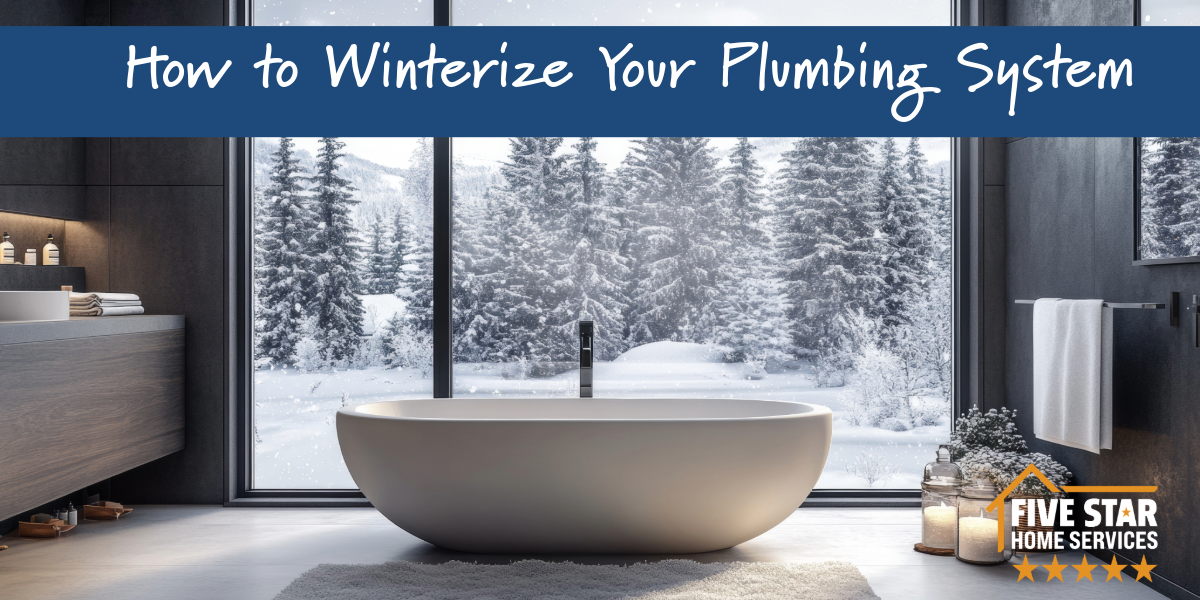13 tips to prepare indoor and outdoor plumbing for winter
What Is Plumbing Winterization, and Why Is It Important?
Plumbing winterization is a crucial process that involves preparing your plumbing system for the cold winter months ahead to prevent expensive damage. This includes draining water from pipes, insulating them, and sealing off any access points to avoid freezing and potential pipe bursts.
The importance of the plumbing winterization process cannot be overstated — especially in areas that experience extreme cold, such as Ohio. Without proper winterization from a professional like Five Star Home Services, water in the pipes can freeze, expand, and eventually cause the pipes to crack or burst.
This not only leads to expensive repairs but also potential water damage to your property. Therefore, plumbing winterization is a preventative measure that safeguards your home during the winter, ensuring the durability and functionality of your plumbing system.
Winterization starts by identifying the vulnerable areas of your plumbing system. This includes outdoor faucets, pipes in unheated areas such as basements and crawl spaces, and any exposed or poorly insulated pipes. These areas are most susceptible to freezing and should be the focus of your winterization efforts. Although there are steps you can take on your own to winterize plumbing, there’s simply no substitute for the assistance of a professional team like our master plumbers at Five Star Home Services. Keep this in mind as we move forward through these DIY plumbing winterization tips.
How to Winterize Your Plumbing System
To help ease your mind, we at Five Star Home Services have a checklist of 13 items to help with the winterization process before you leave your home vacant. Following the steps outlined below should ensure you won’t have to deal with any unpleasant surprises upon your return. As always, a local plumber is your best source for accessing and diagnosing your situation. In the following, we will break down our list into eight steps to winterize interior plumbing and five steps to winterize exterior plumbing.
Eight Steps to Winterizing Interior Plumbing:
As indicated by the name, interior plumbing involves anything within the home. Taking care of your household plumbing can help protect you from having an emergency repair. Here are eight steps to preventing frozen pipes and keeping your interior plumbing working correctly:
- Drain Your Pipes: Begin by turning off the water supply. Open all faucets in your home and allow the water to drain out, reducing the chances of freezing and bursting.
- Insulate Vulnerable Pipes: Identify pipes in unheated areas like basements, attics, or garages. Wrap these pipes with polyethylene or fiberglass insulation tubes.
- Seal Leaks: Check for leaks around your house, especially near pipes. Use caulk to seal any cracks or holes in your walls or floor to keep cold air away from pipes.
- Install Heat Tape: For particularly vulnerable pipes, consider using electric heat tapes that heat the pipes when the temperature drops.
- Adjust Thermostat: Maintain a steady temperature in your home day and night. This constant heat helps prevent pipes from freezing.
- Disconnect Garden Hoses: Detach hoses from outdoor faucets, drain them, and store them away for the winter. If possible, shut off the water to outdoor faucets.
- Protect Indoor Sink Pipes: Open cabinet doors under sinks to allow warm air to circulate the pipes.
- Consider Professional Inspection: If you’re unsure about properly winterizing your home, call the local professionals at Five Star Home Services to inspect your home’s plumbing system. We can provide expert advice and service, ensuring your pipes are ready for winter. There’s no substitute for having a company life Five Star in your home. We encourage you to experience the difference yourself!
Five Steps to Winterize Exterior Plumbing:
Next, we move on to exterior plumbing. Openings in the home should be closed to prevent frigid outside air from contacting indoor pipes. Below are some preventative steps you can take to keep your external plumbing safe:
- Drain Water from Pipes: Begin by draining all water from your exterior plumbing systems, including hoses, pipes, and sprinklers. Water left inside can freeze and cause pipes to burst.
- Insulate Pipes: Use foam pipe insulation to cover your exposed pipes. This insulation layer can protect your pipes from freezing temperatures and prevent them from bursting.
- Shut-Off Valves: If your home has interior shut-off valves leading to outdoor faucets, close them and drain the water from outside lines.
- Protect Outdoor Faucets: Consider investing in a faucet cover for your outdoor faucets. These covers provide an extra layer of protection against freezing temperatures.
- Service Your Sprinkler System: If you have a sprinkler system, get a professional to blow out the sprinklers, removing all water before the freezing temperature sets in.
Need further assistance? Call Five Star!
If you do not have the necessary equipment or skill set to winterize your plumbing, we recommend contacting our professionals at Five Star Home Services for fast, affordable, and reliable help. Our team of master plumbers is experts at winterization and plumbing maintenance. As always, your satisfaction as our customer is our highest priority!

